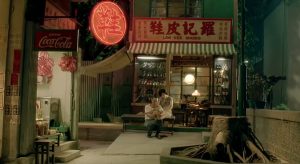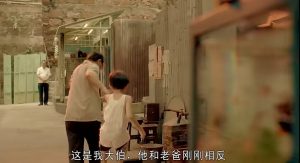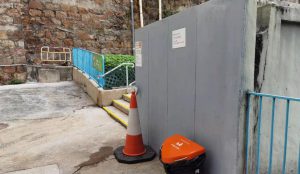ECHOES OF THE RAINBOW, DIR. ALEX LAW (2010)
Wing Lee Street, Sheung Wan, Hong Kong
Echoes of The Rainbow, shot by Alex Law, was released in March 2010 in Hong Kong. The film is about the life of a small family, in which there are great difficulties and little happiness. Wing Lee Street is the main shooting site. Two slog cabins that did not exist in reality have been added to the film. One belongs to a shoemaker, who works and lives in that house with his wife and two sons. It stands at the end of the street and one side of an alley vertical to Wing Lee Street. The other is his barber brother’s home, and the shop is on the other side of the alley. Both of these houses were built temporarily by themselves. The shoemaker’s house is a two-story house. The first floor is not only a shop, but also his bedroom and his wife. On the second floor is the dormitory for two sons. Each floor covers about 10 m^2, which is really narrow for living. There are no staircases and they use ladders to go upstairs.
.
No.10 typhoon destroyed the shoe store. Scenes from the Echoes of The Rainbow 2010, directed by Alex Law.
Why did the director add these two cabins without settling the big family into the tenement house on the street? Firstly it serves the background of the character: the family immigrated from Nanhai to Hong Kong. Immigration was popular in 1960s Hong Kong which caused the lack of residential areas. A large number of self-built houses appeared. They are seeking a safer and more stable life in Hong Kong, but their houses are unstable. One section in the movie shows a typhoon destroying the shoe store. Fragments were flying on the street, and family members together used their bodies to hold their house structure to reduce loss. We could see that the broken pieces are all over the street, making the street a mess. What’s interesting is that the camera is not giving close-up features on the broken cabin. However, it chooses to display a vision that included the whole street. Compared with the tenement house, the fragileness the shoe store is and the helplessness of the family were emphasized. It also shows the whole street and even the whole Hong Kong was in deep distress. This is the first small climax, and it is also the beginning of all subsequent tragedies. Destruction and disappearance is always an important element in movies. As said, “Tragedy is the destruction of valuable thing posters.”1 It may be because people are born to appreciate acquisition and are afraid of loss. Director intends to destroy the fragile house, and the feeling of losing may arouse the audience’s resonance and thinking. Loss is the main topic of the film. When the film reaches the end, we finally realize that the family’s happiness is based not on a stable house but the union of a family. It is amazing that the author successfully used a tragedy to encourage people to face loss in life in a positive mood. It is the old street and what he added to the street helped him to do that.
The added cabin and its destruction may be a metaphor for something that may easily be lost. There is nothing eternal. Time may steal everything. When the film chose Wing Lee Street as their site, this street was in the government’s demolition plan and about to be torn down. There are a lot of scenes given to the street which is like a memory of the street. The street was finally saved as the film gave value to it, which made the government change its mind.2 However, the neighborhood atmosphere and people’s kindness generated in that difficult age has disappeared. This kind of disappearance is inevitable because those precious things are carried by time rather than specific buildings or places. Without those things, the special “space” turns back to a “place”3, which made us reflect on whether it deserves perseverance. Besides nostalgia, do these places still have any significance to us?
— Liu Yichu, 3035773072


- Left: Wing Lee Street. Scenes from the Echoes of The Rainbow 2010, directed by Alex Law.
Right: Current Wing Lee Street. Photo shot by Chelsea Liu, 2021


Left: The alley vertical to Wing Lee Street where the shoe store and barbershop in the film are at. Figures are walking from the shoe store to the barbershop . Scenes from the Echoes of The Rainbow 2010, directed by Alex Law.
Right: Current alley. Photo shot by Chelsea Liu, 2021
Notes:
1.By Lu Xun in his article The Collapse of Leifeng Pagoda, self-transplanted.
2.Information comes from: Pan, Steve, and Chris Ryan. 2011. “Film-Induced Heritage Site Conservation.” Journal of Hospitality & Tourism Research 37 (1): 128–30. https://doi.org/10.1177/1096348011425497.
3.The definition of “space” and “place” refers to: Michel De Certeau, and Steven Rendall. 2011. The Practice of Everyday Life. Berkeley Univ. Of California Press.117-18
Appreciate your thoughtful analysis on the film’s presentation of the makeshift cabins and tenement house on Wing Lee Street and the reflection on the Chinese migrant situation in post-1949 mid-twentieth century HK. Your lead-in question is effective in allowing a close-up view of the street while opening up the broader question of urban housing contingency through the lens of destruction and disappearance. Well done on keeping the analysis focused and discussing the actual and metaphorical process of disappearance. I enjoy your concluding statement and question that seems to reiterate your take on the street as a contestation between space and place vis-à-vis De Certeau’s analysis of space (as produced by the activities taking place within it and thus dynamic/unstable) and place as a stable condition (thus easily invoked by nostalgia?) How would you reflect on your own question on the making of place through nostalgia? Clear and well-articulated writing that demonstrates a thoughtful and sustained intellectual engagement with the subject.